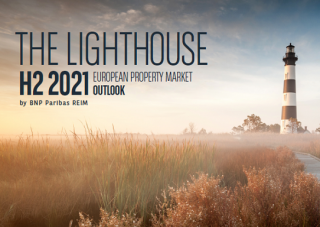Overall, The Lighthouse H2 2021 – A European Property Market Outlook, expresses a positive outlook for the real estate sector. With economic growth remaining strong and inflation high, various factors are contributing to a positive environment for investors. With a number of institutional investors now choosing to increase their real estate allocation within their strategies based on negative real rates, there is a growing demand for such assets.
ESG is today’s number one focus
ESG (Environmental Social Governance) criteria for assets has become a key focus for investors over the last few years. Supported by government regulations and a changing mind-set, investment in ESG has become more mainstream and indeed, called upon. In the Netherlands for example, office buildings will be required to have C-label or better by 2023 in order to be rented out.
With availability becoming increasingly limited, there is likely to be an increase in prices for sustainable assets, which will certainly mean a deeper transformation of the real estate sector.
Healthcare to generate the highest returns
The health crisis has shaken up interest in different assets, with the healthcare sector now having a strong outlook. Indeed, The Lighthouse report predicts that thanks to strong investor demand, the healthcare sector will experience the highest returns over the next five years.

While uncertainties have been cast over more traditional assets such as offices (with the rise of working from home) or retail (with the boom of e-commerce), the healthcare sector seems to have benefited from the crisis. In fact, the underlying economic and demographic trends driving demand for this property type are long-term and structural. We expect the sector to outperform the more traditional asset classes over our forecast period, with strong yield compression and solid rental growth. However, investors will need to be cautious, as the sector is a varied one in terms of both markets and asset types.
The office market remains solid
Remote working has undoubtedly created a new relationship with the office building, but that’s not to say that it has become redundant. On the contrary, the prospects for prime offices appear to be fairly strong, due to an increased focus on prime markets and an accelerated drive for more sustainable and future-proof buildings.
It’s true that after the number of lockdowns which hit the world in 2020, some were sceptical of the need for offices, in light of a new shift towards Working From Home (WFH). It seems however that the issue is not clear-cut and how office space will go on to be used depends on individual companies and their culture. For BNP Paribas REIM, we can be optimistic about the future of the office thanks to a good supply of high quality offices, rising rents and solid investor interest.
The residential sector gains ground
The residential sector has proved itself to be incredibly robust in the face of the health crisis, along with healthcare it is gaining the most investment inflows for this year. This confirms the idea that investors’ strategies are changing, as they move away from traditional sectors such as retail and offices and expand their portfolios, in a quest for low volatility.
Benoit Lefebvre explains that, “Now more than ever, institutional investors are looking to the residential sector to expand their portfolios. Indeed, according to RCA, European investment over the first three quarters of 2021 was 29% above the five-year average, outperforming the majority of other asset classes (see Exhibit 28). The relatively stable cash flows and returns, together with low volatility, are attractive in this period of high uncertainty. Moreover, as the sector is positively impacted by population growth in urban areas and the structural shortage of supply, investors are reallocating their port-folios to increase their residential holdings.”
A European real estate market that remain resilient
European real estate markets have continued to stand-up in the face of the pandemic. As we end a second year within this context though it is clear to see that events have changed the face of the real estate industry and requited investors to change their strategies. With assets such as logistics and healthcare performing above their pre-crisis levels, there is change within the sector. This is further acceleration by greater digitalisation, changing lifestyles and demographic.

It is generally accepted that we shall end up somewhere completely different to where we were in Q4 2019. For all these reasons, it will be difficult to compare post-Covid with pre-Covid.

The Lighthouse H2 2021
Download your copy of The Lighthouse H2 2021 – A European Property Market Outlook




